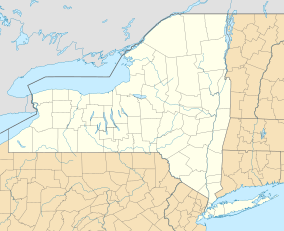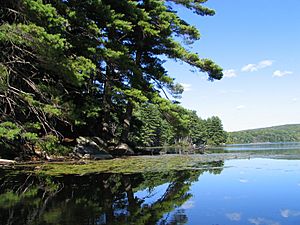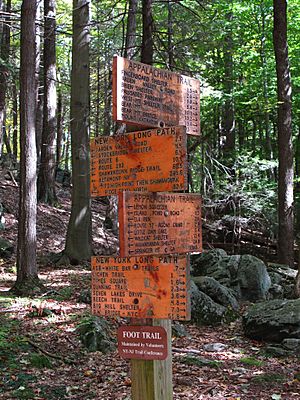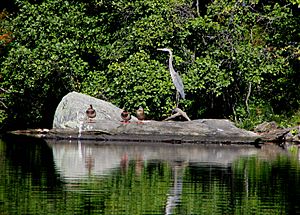Harriman State Park (New York) facts for kids
Quick facts for kids Harriman State Park |
|
|---|---|

View from Harriman State Park, facing north
|
|
| Location | Orange / Rockland counties, New York, United States |
| Area | 47,527 acres (192.33 km2) |
| Established | 1910 |
| Visitors | 1,425,000 (in 2014) |
| Governing body | Palisades Interstate Park Commission |
Harriman State Park is a huge natural area in New York State. It covers about 47,527 acres, which makes it the second-largest state park in New York. You can find it in Rockland and Orange counties, about 30 miles north of New York City.
This park is a fantastic place for people who love the outdoors. It has over 200 miles of hiking trails. Harriman State Park is also famous for its 31 lakes, many streams, public camping spots, and amazing views. Volunteers from the New York - New Jersey Trail Conference help take care of the hiking trails.
Harriman State Park shares its borders with other large protected areas. To the northeast, it touches Bear Mountain State Park and a forest reserve belonging to the United States Military Academy at West Point. To the southwest, it borders the Sterling Forest reserve. All these areas together create a huge protected forest, much bigger than Harriman State Park alone.
Park History
The story of Harriman State Park began with a wealthy family, Edward and Mary Averell Harriman. They owned a large estate of about 30,000 acres in Arden, New York. When the state planned to build a prison at Bear Mountain, the Harrimans were not happy about it. They wanted to protect the beautiful land.
After her husband Edward passed away in 1909, Mary Harriman came up with a generous idea. She offered to donate 10,000 acres of land and $1 million to New York State. This gift was meant to help create a new state park. In return, she asked the state to cancel the prison plan. She also wanted the state to add $2.5 million to buy more land and build park facilities.
The state agreed to her proposal. The Palisades Interstate Park Commission, which manages parks, would also get more power to look after land in the Ramapo Mountains and Hudson Highlands. On October 29, 1910, Mary Harriman's son, W. Averell Harriman, officially gave the land deed and the million-dollar check to the Commission. This is how Harriman State Park was born!
After the park was created, work began to make it easier for people to visit. In 1913, Major William A. Welch started building a road from Bear Mountain to Sloatsburg. Today, this road is known as the Seven Lakes Drive. Later, in 1962, another road was opened from Tuxedo to Kanawake Circle. Many other roads were also built around Bear Mountain to help visitors get around.
Back then, you could even take a steamboat from Manhattan to the park. A round-trip ticket cost 85 cents for adults and 45 cents for children.
During the Great Depression in the 1930s, the park received a lot of help. The Civilian Conservation Corps (CCC) was a program that gave jobs to thousands of young men. They worked on building roads, trails, camps, and even new lakes in the park. Some of the lakes they helped create include Pine Meadow, Wanoksink, Turkey Hill, Welch, Silvermine, and Massawippa Lakes.
In 1993, a big international event called the World Orienteering Championships was held at Harriman State Park.
Hiking Trails
Harriman State Park is a hiker's paradise! It has more than 40 marked hiking trails, adding up to 225 miles. There are also 57 unmarked trails and old woods roads, which are only for walking, covering another 103 miles.
Some of the well-known trails include:
|
|
Besides hiking, you can also find horse trails in the southeastern part of the park. There's a mountain bike trail at the Anthony Wayne Recreation Area in the northeast. In winter, some trails are open for cross-country skiing. The New York - New Jersey Trail Conference helps keep all these trails in good shape.
Park Environment
Harriman State Park is part of a natural area called the Northeastern coastal forests ecoregion. This means it has certain types of plants and animals that are common in coastal forest areas of the northeastern United States.
Lakes and Ponds
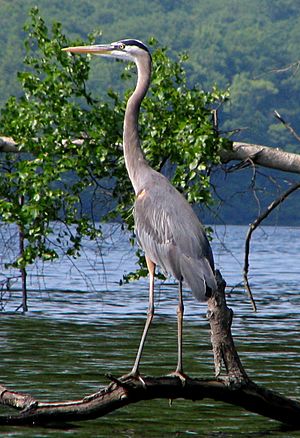
Harriman State Park is home to 32 beautiful lakes and ponds. Many of them offer fun activities for visitors.
Here are some of the larger ones:
- Lake Sebago, 310 acres, great for boating and cabin camping.
- Lake Tiorati, 291 acres, has a swimming beach and a boat launch.
- Lake Welch, 216 acres, offers a swimming beach and camping.
- Lake Kanawauke (which is actually three connected lakes), 186 acres.
- Lake Stahahe, 88 acres.
- Silver Mine Lake, 84 acres.
- Pine Meadow Lake, 77 acres.
- Turkey Hill Lake, 58 acres.
- Island Pond, 51 acres.
- Lake Askoti, 41 acres.
- Lake Skanatati, 38 acres.
- Lake Wanoksink, 38 acres.
- Lake Skenonto, 37 acres.
- Queensboro Lake, 35 acres.
- Hessian Lake, 33 acres.
- Summit Lake, 33 acres.
-
Red eft on the Suffern-Bear Mountain Trail
-
Otter at Lake Sebago
-
Timber rattler near the Suffern-Bear Mountain Trail
-
American black duck at Lake Sebago
-
Black snake on the Pine Meadow Lake Trail
-
White-tailed deer at Lake Kanawauke
Park Roads
Several important roads and parkways run through Harriman State Park, making it easy to explore. These include:
- Palisades Interstate Parkway
- Seven Lakes Drive
- Long Mountain Parkway
- Lake Welch Parkway
- Tiorati Brook Road
- Arden Valley Road
- Orange-Rockland CR 106


